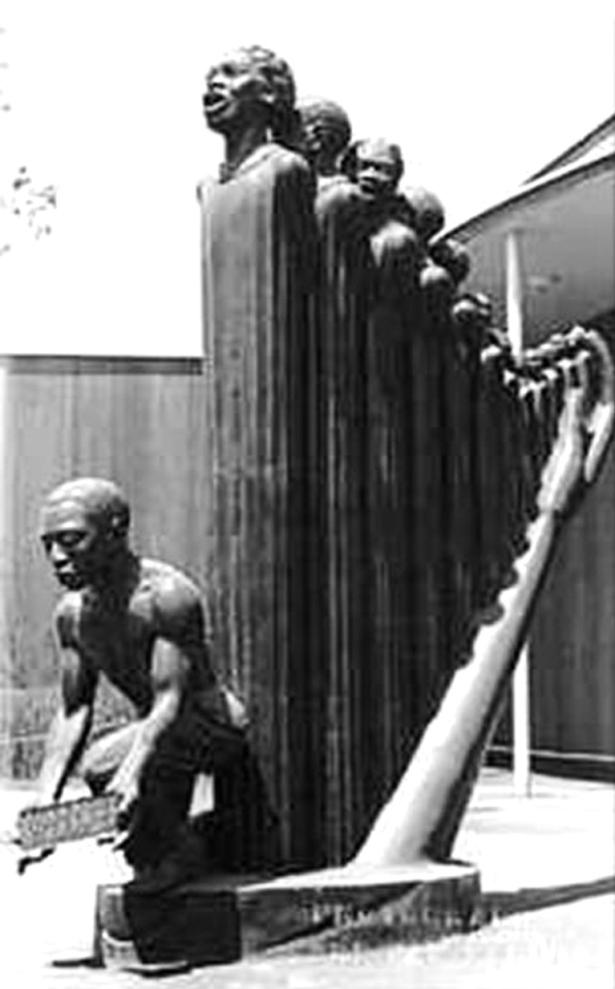Lift Every Voice and Sing!
FEBRUARY 12, IN ADDITION TO BEING LINCOLN’S BIRTHDAY, IS ALSO THE 125TH ANNIVERSARY of the first public recitation, in 1900, of the poem “Lift Every Voice and Sing” by James Weldon Johnson. The poem’s vivid, hymn-like lyrics were soon set to equally stirring music by the author’s brother, J. Rosamond Johnson.
From the first, Lift Every Voice and Sing was immensely popular among the Black community of Tallahassee, Florida, where it was first performed. It was almost immediately recorded and quickly earned a broad and appreciative audience, mostly in Black communities, throughout the U.S.
In 1919, the NAACP declared that Lift Every Voice and Sing had become the "Negro national anthem." In more recent days, it has come to be known as the Black national anthem. If you haven’t heard it lately, or even if you have, listen to the rendition here, which includes the lyrics for anyone inclined to sing along: https://youtu.be/ONgOH_tq7-Q?si=9LSfzhOGNPktuRON
The image shows a sculpture by Augusta Savage, entitled “Lift Every Voice and Sing”. Savage created it for the courtyard of the Pavilion of Contemporary Art at the 1939 New York World’s Fair, which was where the photo was taken. Unfortunately, the art work was destroyed shortly after the fair closed in late 1940.
Michigan Resists So-Called Fugitive Slave Act
FEBRUARY 13 IS THE 170TH ANNIVERSARY OF Michigan enacting a law to discourage enforcement of the federal Fugitive Slave Act of 1850.
Michigan’s 1855 law, “The Protection of the Rights and Liberties of Persons Claimed Fugitive Slaves,” required local prosecutors to do everything legally possible to “protect and defend” anyone claimed to be a fugitive slave; it gave alleged fugitives the rights of habeas corpus and trial by jury; it prohibited the use of public jails or prisons to hold alleged fugitives; and it made it a crime, punishable by five years in prison, to falsely claim anyone to be a fugitive slave.
Michigan was the second state to enact such a law, after Connecticut did so in 1854. Similar laws were soon enacted in Maine and Massachusetts (1855), in New Hampshire, Ohio and Wisconsin (1857), and in Vermont (1858). https://michiganology.org/stories/anti-slavery-movement-in-michigan/
Our Place in the Universe
FEBRUARY 14 IS THE 35TH ANNIVERSARY of the day in 1990 when the spacecraft Voyager 1, having left the Solar System on its journey to interstellar space, looked back to where it had been launched and captured an image of the Earth as it had never been previously seen.
Taken from a location that is more than 40 times the distance from the Earth to the Sun, the Earth shows up as a pale blue dot. The image, which was captured at the suggestion of astronomer Carl Sagan, inspired Sagan to write “Pale Blue Dot: A Vision of the Human Future in Space,” which was published in 1994.
Sagan made a 3-minute video, Pale Blue Dot, in which he reflects on the photo’s significance You can watch it: https://youtu.be/GO5FwsblpT8?si=wtm376E4iUfLtaIK
Confronting a Campaign of Terror
FEBRUARY 17 IS THE 10TH ANNIVERSARY of the publication of “Lynching in America: Confronting the Legacy of Racial Terror” by the Equal Justice Initiative.
The exhaustively detailed 2015 report found that far more African-Americans had been lynched between 1877 and 1950 than was previously believed. It concludes that “Lynching in America was a form of terrorism that has contributed to a legacy of racial inequality that our nation must address more directly and concretely than we have to date.”
To view the entire report, including more the 30 illustrations, visit https://lynchinginamerica.eji.org/report/
An Outrageous Verdict, Reversed on Appeal
FEBRUARY 18 IS THE 55TH ANNIVERSARY of the end of the raucous four-and-a-half month trial of the Chicago 7 in 1970. All the defendants were acquitted of the most serious charge – conspiracy to incite a riot during the Democratic Party’s nominating convention in 1968. However, five defendants – Dave Dellinger, Rennie Davis, Tom Hayden, Abbie Hoffman and Jerry Rubin – were convicted of having individually promoted the rioting. Two defendants – John Froines and Lee Weiner – were acquitted of all charges.
Shortly after the verdicts were announced, the five defendants who had been convicted released a statement: “The outrageous verdict results from the unholy combination of an unconstitutional law, a [Mayor John] Daley prosecutor, and a hostile authoritarian judge . . . .
“Everyone who opposes the war against Vietnam – and everyone who advocates the liberation of Black people – everyone with long hair and a free spirit – everyone who condemns the existence of poverty here and throughout the world – all have been found guilty by this verdict.
“This day will live in infamy. But the final jury is the people and their verdict is already beginning to come in, We await the final verdict of the people.”
Eventually, the U.S. Court of Appeals reversed all of the convictions, finding not only that the trial Judge. Julius Hoffman, had committed numerous errors. but also “the demeanor of the judge and the prosecutors would require reversal even if errors did not.” https://lawecommons.luc.edu/cgi/viewcontent.cgi?article=2702&context=luclj
For more People's History, visit
https://www.facebook.com/jonathan.bennett.7771/


Spread the word